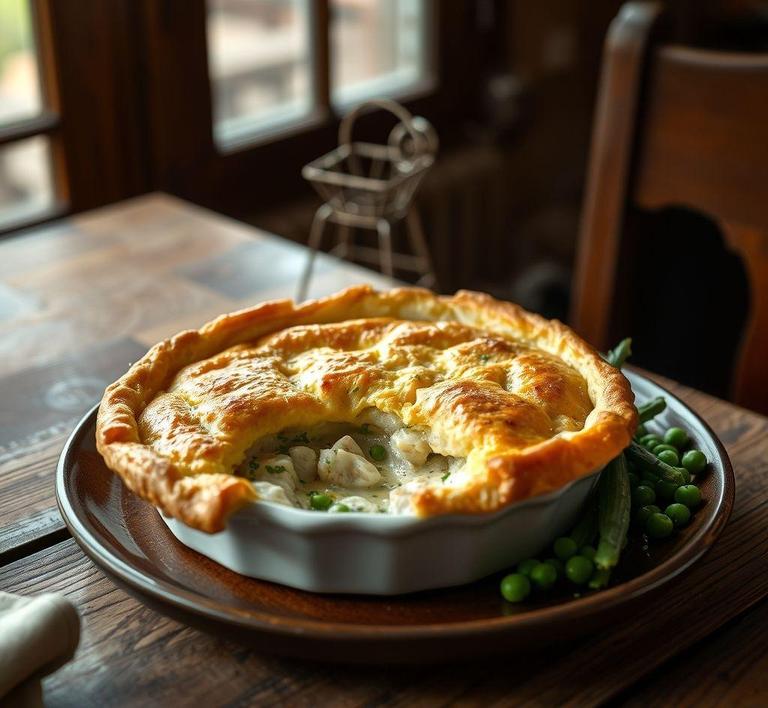Refreezing fish pie can be a bit tricky, but with the right approach, you can safely preserve it for future meals. Whether you’ve got leftovers or made too much for one sitting, understanding how to properly refreeze fish pie ensures it retains its taste and texture. While freezing fish pie initially can keep it fresh, the key to successfully refreezing lies in how you handle the thawing and reheating process. In this guide, we’ll walk you through the best practices for refreezing fish pie without compromising on quality, so you can enjoy your dish again without worry!
Can You Refreeze Fish Pie?

When it comes to refreezing fish pie, the answer isn’t a simple yes or no-it depends heavily on how the fish pie has been handled since it was first thawed. Fish pie is a delicate dish, often containing cooked fish, creamy sauces, and a mashed potato topping. Each of these components has its own sensitivity to temperature changes and food safety risks.
From a food safety perspective, refreezing fish pie that has been thawed but left out at room temperature for too long is risky. The main concern is bacterial growth. When fish pie is thawed, bacteria that might have survived freezing can begin to multiply if the temperature stays in the ‘danger zone’ (between 4°C/40°F and 60°C/140°F) for too long. Refreezing under such conditions does not kill bacteria; it merely pauses their growth. Once thawed again, these bacteria can multiply rapidly, increasing the risk of foodborne illness.
However, if the fish pie has been thawed in the refrigerator and kept at a safe temperature (below 4°C/40°F) and has not been left out for more than 24 hours, then refreezing can be done safely. This is because low temperatures slow bacterial growth, maintaining the pie’s safety for a second freeze.
From a culinary standpoint, refreezing fish pie can affect texture and flavor. Each freeze-thaw cycle can cause ice crystals to form and rupture cell walls in both the fish and the potato topping, leading to a soggy or mushy texture. The creamy sauce may also separate or become grainy after refreezing. While still edible, the overall eating experience may be compromised.
How To Refreeze Fish Pie?
If you decide to refreeze your fish pie, the method matters a lot. Here’s a step-by-step guide to doing it safely and with as little loss of quality as possible:
- Initial Thawing: Always thaw fish pie in the refrigerator, never on the counter. This keeps the pie at a safe temperature and slows bacterial growth.
- Check Freshness: Before refreezing, inspect the fish pie for any off smells, discoloration, or sliminess. If anything seems off, discard it.
- Cool Down Properly: If the fish pie was freshly cooked and you want to freeze leftovers, allow it to cool completely in the fridge first. Placing warm pie directly in the freezer can raise the temperature inside and promote bacteria growth in surrounding foods.
- Portioning: Divide the pie into smaller portions before freezing. This way, when you thaw it next time, you only thaw what you need, reducing the number of times you have to refreeze leftovers.
- Packaging: Wrap the portions tightly in cling film or aluminum foil, then place them inside airtight freezer bags or containers to prevent freezer burn and moisture loss.
- Labeling: Always label your fish pie with the freezing date. Ideally, consume refrozen fish pie within 1 month for best quality.
- Refreezing Timeframe: Only refreeze fish pie that has been thawed in the fridge and has been kept cold for no longer than 24 hours. Never refreeze fish pie that has been thawed on the counter or left out too long.
- Reheating: When you’re ready to eat the refrozen pie, thaw it again in the fridge overnight and reheat thoroughly to at least 75°C (165°F) before consuming.
Quality Impact
Refreezing fish pie inevitably affects its quality, and here’s why:
- Texture Changes: Fish flesh is delicate and tends to become flaky or mushy after repeated freezing. The mashed potato topping, which ideally should be fluffy, can become grainy or watery due to ice crystal damage during freezing and thawing cycles.
- Moisture Loss: Freezing causes water molecules in the food to expand into ice crystals. These crystals can puncture cell walls, causing the pie to lose moisture once thawed. This leads to dryness in the fish and a less creamy sauce.
- Flavor Deterioration: The subtle flavors in the fish and sauce may dull or become muted after refreezing. Some sauces may separate or develop a slightly off taste due to the breakdown of fats and emulsions.
- Appearance: Refrozen fish pie can lose its visual appeal as the surface may look dry or cracked, and sauces might curdle or separate.
That said, with careful handling and quick freezing, the quality loss can be minimized. Using airtight packaging and freezing as soon as possible after cooking or thawing helps preserve texture and flavor better.
yes, you can refreeze fish pie, but with important caveats. The key is ensuring food safety first by only refreezing if the pie was thawed properly in the refrigerator and kept at safe temperatures. Refreezing fish pie can save leftovers and reduce waste but will come with some loss of quality in texture, moisture, and flavor.
If you want to enjoy your fish pie at its best, try to freeze it only once and eat it soon after thawing. But if you must refreeze, follow safe practices-keep it cold, portion it well, package tightly, and always reheat thoroughly. This way, you can still enjoy the comforting flavors of fish pie with peace of mind.
Is It Safe To Refreeze Fish Pie?
Fish pie is a beloved comfort food, packed with tender fish, creamy sauce, and fluffy mashed potato topping. But what happens if you have leftovers or thawed fish pie that you can’t finish? The question of whether it’s safe to refreeze fish pie is more nuanced than a simple yes or no.
From a food safety perspective, refreezing fish pie is generally discouraged, but it can be done safely under certain conditions. The key factor is whether the pie has been kept at safe temperatures throughout the entire process. The United States Department of Agriculture (USDA) advises that once a food containing seafood has been thawed in the refrigerator and remains at or below 40°F (4°C), it can be safely refrozen without cooking, but this should ideally be done within a couple of days.
However, there’s a catch: each freeze-thaw cycle affects the texture and quality of the fish and the creamy filling. Fish flesh is delicate, and freezing causes ice crystals to form inside muscle fibers, which can rupture cell walls and lead to a mushier texture when thawed. Repeated freezing compounds this effect, making the pie less appetizing.
If the fish pie has been fully cooked before freezing and then thawed properly in the fridge, refreezing it after reheating is generally safer and better for texture. The heat from reheating kills bacteria, which may have begun to grow during the thawing period. But refreezing without cooking in between carries more risk of bacterial growth if temperature guidelines haven’t been strictly followed.
In summary, yes, it can be safe to refreeze fish pie if:
- It was thawed in the refrigerator and hasn’t been left out at room temperature for over two hours.
- It is refrozen promptly, ideally within 1-2 days after thawing.
- It has been reheated to an internal temperature of 165°F (74°C) before refreezing (recommended for safety).
But quality will degrade, and if you’re unsure about handling, it’s better to cook and consume or discard.
Signs That Fish Pie Should Not Be Refrozen
Knowing when not to refreeze fish pie is just as critical as knowing when you can. Here are some warning signs that your fish pie should not be subjected to another freezing cycle:
- Unpleasant Odor: Fish pie should smell fresh and creamy, with no sour or ammonia-like smells. A pungent, off-putting odor is a red flag indicating bacterial spoilage.
- Change in Texture: If the mashed potato topping is watery, slimy, or the fish filling appears overly mushy or grainy beyond normal thawing effects, this signals protein breakdown.
- Visible Mold or Discoloration: Any sign of mold or odd discoloration, such as greenish or black patches, means the pie is unsafe to consume or refreeze.
- Extended Time at Room Temperature: If the fish pie has been left out at room temperature for more than two hours (or one hour above 90°F/32°C), harmful bacteria can multiply rapidly. Refreezing after this exposure is risky.
- Unusually Wet or Excess Moisture: When thawed fish pie releases excessive liquid or the filling becomes soupy, it may indicate bacterial degradation or spoilage enzymes at work.
- Previous Refreezing: If the fish pie has already been refrozen once or twice before, it’s best to avoid refreezing again. Multiple freeze-thaw cycles dramatically reduce safety and quality.
If you observe any of these signs, it’s best to err on the side of caution and avoid refreezing-or even consuming-the fish pie.
Common Refreezing Mistakes
Many of us unknowingly make mistakes that compromise the safety and taste of refrozen fish pie. Here are some of the most frequent pitfalls:
- Thawing at Room Temperature: Leaving fish pie out to thaw on the countertop or in warm conditions invites bacterial growth. Always thaw in the fridge or cold water (sealed tightly).
- Refreezing After Extended Time: Waiting too long after thawing before refreezing allows bacteria to multiply. Refreeze as soon as possible, ideally within 1-2 days.
- Refreezing Without Reheating: Refreezing thawed fish pie without cooking it again can preserve bacteria that might have grown during thawing.
- Ignoring Packaging: Refreezing fish pie in the original packaging without resealing can cause freezer burn. Air exposure damages flavor and texture.
- Refreezing Large Portions: Freezing large amounts at once slows the freezing process, increasing ice crystal size and damage. It’s better to freeze in smaller portions.
- Not Labeling: Without clear date labels, it’s easy to forget how long something’s been in the freezer, increasing the risk of refreezing spoiled food.
Avoiding these mistakes will help maintain both safety and the deliciousness of your fish pie.
Tips And Tricks
To get the most out of your fish pie when it comes to freezing and refreezing, here are some practical tips:
- Portion Wisely: Freeze leftovers in small, meal-sized portions. This allows you to thaw only what you need, reducing waste and refreezing frequency.
- Use Airtight Containers: Invest in airtight, freezer-safe containers or wrap pie tightly in cling film followed by foil to prevent freezer burn.
- Label Everything: Always mark packages with the date frozen and contents. Use the ‘first in, first out’ principle to consume older items first.
- Thaw Safely: Thaw fish pie overnight in the fridge. For quicker thawing, use a sealed bag submerged in cold water, changing water every 30 minutes.
- Reheat Thoroughly: When reheating fish pie, heat it to at least 165°F (74°C) to ensure any bacteria are killed.
- Freeze Quickly: Speed freezing by placing portions on a tray in the freezer for a few hours before transferring to containers. Faster freezing means smaller ice crystals and better texture retention.
- Avoid Multiple Refreezing: If you know you’ll have leftovers, freeze once and portion carefully to avoid needing to refreeze.
By following these tips, you’ll keep your fish pie safe, tasty, and as close to freshly made as possible-even after freezing.
Conclusion
Refreezing fish pie isn’t a simple yes-or-no question. While it is technically safe under strict conditions-proper refrigeration during thawing, prompt refreezing, and ideally reheating before refreezing-it comes with risks to food safety and quality. The delicate nature of fish and creamy sauces means each freeze-thaw cycle degrades texture and flavor, and improper handling invites harmful bacterial growth.
Recognizing the signs of spoilage, avoiding common freezing mistakes, and adopting smart freezing practices can help you enjoy your fish pie leftovers safely and deliciously. When in doubt, prioritize safety: discard questionable pie rather than risking foodborne illness. But with care and attention, refreezing fish pie can be a practical solution to reduce waste and enjoy your comfort food over multiple meals.


